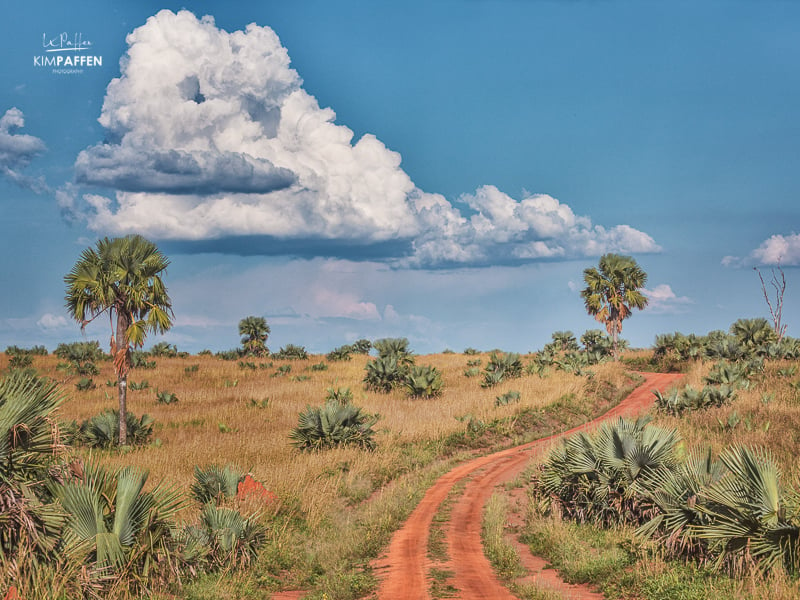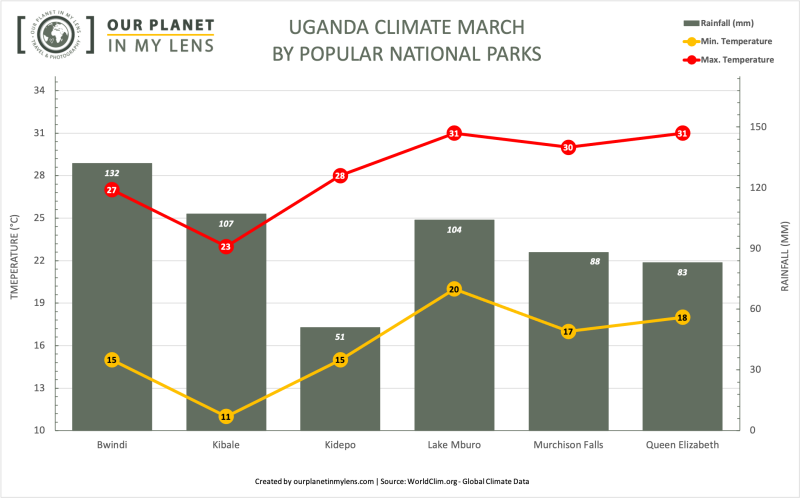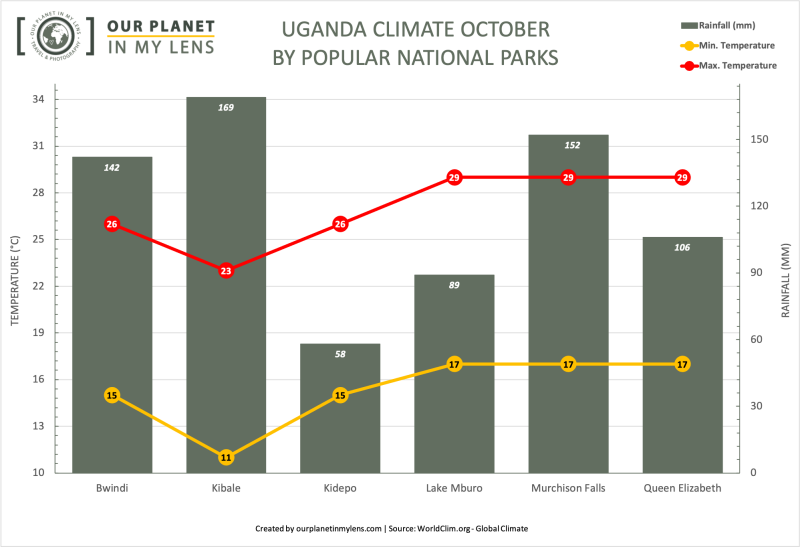
Uganda weather by month
When to go to Uganda? Uganda is a year-round safari destination, and every month has its own beauty. In this article, I will explain the weather and climate in Uganda month-by-month, including the average temperature in Uganda, the amount of rainfall, game viewing options, the conditions for gorilla trekking, and birdwatching opportunities. That way, you can choose your preferred period of traveling to Uganda.
Uganda in January
 Uganda climate chart for travel in January
Uganda climate chart for travel in January
As part of Uganda's dry season, January is among the best time of the year to visit Uganda, although rainfall can be expected in any month because of the country's tropical climate and location on the equator. However, these rain showers are very short and an exception rather than the norm. The average temperature in Uganda in January is around 24 degrees with temperatures around 30 degrees in the north. The roads are dry and the skies are blue.
Wildlife viewing is good during this driest month of the year as there is less vegetation which makes wildlife spotting easier. January until April is also a great period to spot a variety of migratory birds.

January is perfect for gorilla trekking in Bwindi Impenetrable National Park as well as Chimpanzee trekking in Kibale. Despite the hot temperatures in January, the rainforests are situated at higher altitudes that take the edge of the heat. Apart from that, the dry ground makes walking easier than in the wet season.
Because the school holidays of December are over, most camps and lodges are quieter in January than in December. Because January is peak season in Uganda, prices of accommodation are higher.
Uganda in February
 Uganda climate chart for travel in February
Uganda climate chart for travel in February
February is part of Uganda's dry season and therefore an ideal time to visit Uganda. The pleasant temperatures, clear skies, and dry conditions are perfect for outdoor activities like primate trekkings, safari game drives, boat tours, and hiking and rafting.
The average temperature in Uganda in February is around 24,5 degrees with an average maximum temperature of 32 degrees in Northern Uganda, making February the hottest month in Uganda.
Because of the drought vegetation becomes sparse which makes wildlife easy to spot as the animals gather at waterholes or along rivers, which makes February a great month for game viewing and boat safaris in Uganda; for example on the Kazinga channel in Queen Elizabeth or in Murchison Falls.

For bird watchers, February is one of the best months of the year in Uganda to watch migratory birds. A great national park to visit in February is Kibale Forest National Park, where you can spot 13 primate species including the Colobus monkey and chimpanzees. The trails are dry which makes this an ideal month for Chimpanzee trekking.
Throughout the country, the temperature drops at night, so take a fleece for the colder evenings and mornings. Tourism numbers in February are a bit lower than in December and January, meaning prices of hotels and lodges change accordingly.
Uganda in March
 Uganda climate chart for travel in March
Uganda climate chart for travel in March
March is the beginning of the long rainy season in Uganda that will last until May. Expect long heavy rain showers that mostly occur in the afternoon or during the night. After a downpour, skies will quickly brighten up.
Although March is not the best month to visit Uganda, it's still a good time to explore Africa's Pearl - including tracking gorillas and chimps. During the day there's still plenty of sunshine with an average day temperature in March of 24,5-26 degrees. Flowers are in bloom and the national parks are lush green with animals giving birth to their young; a beautiful time to visit Uganda. Vegetation makes spotting wildlife a bit harder, but you’ll still see plenty of wildlife in f/e Queen Elizabeth. Uganda in March is the last month to watch migratory birds as they will start to depart in April and return in November. However, bird watching is good all year round.

Just be aware that the heavy rains can impact the conditions of the roads, making routes less accessible and trekking trails more slippery. On the other hand, the trekking may be shorter as gorillas tend to move to the lower mountain slopes as there's enough food. Chances are high that you encounter gorillas closer to the beginning of the trail.
RELATED: Read more about Gorilla Trekking in Uganda and the advantages of tracking gorillas in the rainy season.
March is part of Uganda's low season, meaning prices of accommodation and various activities, including the primate treks, are likely to be lower making gorilla trekking a more affordable experience.
Uganda in April
 Uganda climate chart for travel in April
Uganda climate chart for travel in April
April is the wettest month of the year in Uganda with the highest rainfall and worst weather with an average daytime temperature of 24 degrees. As April is the peak of the long rainy season in Uganda, traveling during this period means activities and lodges can be cheaper. Some accommodations can be closed and roads might be inaccessible because of the rains.

Apart from the wet weather, April (just like March) is one of the most beautiful times to visit Uganda as the reserves and national parks are lush green with lots of birdlife and wildlife, and the top of the trees are covered in mist. If you want to escape the rain, you can try your luck in Murchison Falls National Park as South-West Uganda has a drier climate.
The advantage of mountain gorilla trekking in April is that treks - although muddy - can be shorter because the gorillas tend to stay around the slightly warmer lower mountain slopes during the rainy season where they can find enough food. Gorilla permits in the rainy season are often more affordable with discounts of up to 25%.
Uganda in May
 Uganda climate chart for travel in May
Uganda climate chart for travel in May
May is the last month of the long rainy season in Uganda with heavy downpours and roads in poor conditions. Therefore, May is not the best time to visit Uganda. Because of the bad weather, some lodges close their doors and the accommodations that remain open have lower rates during the low season.
If you're not too worried to experience some rain, May can be a lovely time to visit Uganda. During the day there's enough sunshine. Days are warm and wet with an average daytime temperature of 23 degrees Celsius. Uganda's landscapes are lush and verdant, which makes spotting wildlife a bit harder, but you’ll still see enough wildlife, and the vegetation, as well as the clouds, can create stunning backdrops for photography.

May is not the best time for gorilla trekking in Bwindi as the ground is still wet and slippery making the hikes more difficult. The advantage is that permits will be cheaper and the length of the trekking shorter as the gorillas are on the lower slopes.
A great national park to visit in Uganda in May is Kibale National Park as the chimpanzee groups are most active during this period. The Chimpanzees can also be found in Murchison Falls National Park, which is located in a drier area and amazing to witness the Nile River. May is also an excellent time for bird watchers to spot various bird species. The best time for bird watching in Uganda is from late May through September when the country experiences less rain and enough food for birds.

Towards the end of May, the weather conditions will get better with less frequent rain showers.
Uganda in June
 Uganda climate chart for travel in June
Uganda climate chart for travel in June
June is the start of the peak season in Uganda and one of the best times of the year to visit the Pearl of Africa. The heavy rains as part of the wet season have passed and left a lush green environment with clear blue skies. An amazing time for wildlife viewing with photogenic sceneries everywhere. A perfect period for photo safaris in Uganda.
The mean temperature in Uganda in June is around 23 degrees with an average maximum temperature of 28,5 degrees Celcius.

Because June is the start of the high season in Uganda, gorilla permits are likely to sell out quickly. In the dry season, gorilla trekkings take longer because the gorilla groups are found higher in the mountains. Since the ground is dry, the hike to the gorillas is more comfortable.
A must-visit national park after the rainy season is Murchison Falls as the falls still flow with enormous power. Although June is Uganda's peak season, it doesn't feel busy or overcrowded in the parks and reserves.
Uganda in July
 Uganda climate chart for travel in July
Uganda climate chart for travel in July
Part of the dry season, July is known as the driest month in Uganda with cooler temperatures across the country. Expect bright sunny days with a sporadic rain shower in the afternoon. The mean temperature in Uganda in July is around 22-23 degrees Celcius with an average maximum temperature of 28 degrees. Just like June, July is a great month to explore the Pearl of Africa. Because of the higher altitude of Lake Victoria, temperatures are slightly cooler around the lake; especially in the morning and late evenings so make sure to take a fleece.

July in Uganda is one of the most popular months to visit due to the good weather, dry road conditions, and (foreign) school holidays. A disadvantage of visiting Uganda in July is the higher price for accommodations and activities.
July is one of the best months for gorilla trekking, chimpanzee trekking, and Big 5 safaris in Uganda. In the national parks like Queen Elizabeth, Kidepo, or Murchison Falls, the wildlife congregates around waterholes or along rivers, making them easier to find. July is also a good month to see the tree-climbing lions in Ishasha.

If you want to track gorillas in July, make sure to book your gorilla permit well in advance. The primate trekking conditions are the same as in June: hikes to find the gorillas take longer as the great apes trek from the lowland to the higher mountain parts of the rainforest, but the conditions are perfect with dry paths and pleasant temperatures.
Uganda in August
 Uganda climate chart for travel in August
Uganda climate chart for travel in August
August is the last month of Uganda's dry season with perfect weather conditions like blue skies, lots of sunshine, and dry roads and trails. The mean temperature in Uganda in August is 23 degrees Celcius with an average maximum temperature of 28,5 degrees Celcius.
August is among the most popular months to visit Uganda, with the national parks being at their best for a safari in August. The dry season is good for wildlife spotting as there is less vegetation to obstruct the view and a variety of wildlife can be seen at waterholes.

Expect to find big cats and elephants. In Queen Elizabeth National Park you can go on safari to find 4 of the Big 5 animals and end your day with a picture-perfect African sundowner overlooking the plains. Visiting Uganda in August is also a great time for tracking chimpanzees, gorilla treks, and bird watching - including bird photography.
Uganda in September
 Uganda climate chart for travel in September
Uganda climate chart for travel in September
Uganda in September is known as the end of the dry season, however, mid-September can also experience some downpours due to the start of the short rainy season from October to November.
The short rains are not as heavy as the ones from March to May which makes September a perfect month for safari and wildlife viewing in Uganda. The animals continue going to the waterholes, meaning the wildlife is still easy to spot.
Because more school holidays come to an end and the weather conditions are less popular by tourists traveling to Uganda, visitor numbers are lower meaning the places to stay in Uganda are cheaper during this time of the year. The mean temperature in Uganda in September is 23 degrees with an average maximum temperature of 29 degrees Celsius.

By the end of September, rain showers will get more frequent and roads will become more slippery. Gorilla trekking can therefore be more challenging but definitely not impossible. In September it's also possible to have a completely dry month, which makes wildlife easier to find thanks to grazed-down vegetation and their presence around waterholes.
Due to the bad weather, Kibale National Park isn't the best park to visit in Uganda in September. If you want to go chimpanzee trekking in September it's best to reconsider your Uganda travel plans. The best period for chimpanzee trekking is in the dry seasons: January and February and June and July.
Uganda in October
 Uganda climate chart for travel in October
Uganda climate chart for travel in October
October is part of the short rainy season in Uganda and rains are more frequent than in September. However, visiting Uganda in October still offers excellent opportunities to observe wildlife as vegetation remains sparse and animals continue to search for waterholes. All national parks in Africa's Pearl remain open, they just aren't at their best.
Uganda's mean temperature in October is 23 degrees Celcius, with average maximum temperatures of 29 degrees Celcius. There's still enough sunshine but expect more frequent heavy downpours. Because October is a wet season, this month is also marked as the low season in Uganda which means travelers to Uganda can benefit from reduced rates for accommodation in Uganda, and gorilla and chimp treks are less likely to sell out quickly. You might even be lucky to plan your gorilla trek last minute.

In Uganda's wet season gorillas descend to the lower slopes of Bwindi Impenetrable Forest National Park because of the more pleasant warmer temperatures and availability of food. This makes gorilla treks much shorter, although the routes can be more slippery due to the rains. An advantage of seeing the gorillas in October is the reduced rates for gorilla permits.
Uganda in November
 Uganda climate chart for travel in November
Uganda climate chart for travel in November
Considered a wet season, November sees dry plains gradually turn emerald green in Uganda's National Parks due to heavy rain showers. Although the rains are less heavy than those of the long rainy season from March to May, it's possible that lodges located in high-rainfall regions close down. Also, expect muddier road conditions and slippery paths when tracking primates.
Other than that, November is still a good time to travel to Uganda. It's the final month of the short rainy season with enough sunshine, but be prepared for rain showers and greyer skies with a mean temperature in November of 23,3 degrees Celcius and an average maximum temperature of 29,6 degrees Celcius.

The most rain falls in Southern Uganda, therefore it's a good option to visit Northern Uganda, including Kidepo Valley National Park with an average daytime temperature of 29,6 degrees. Another great park to visit in November is Murchison Falls. This is a year-round destination where you can admire the power of the Nile river and spot animals like hippos, crocodiles, elephants, giraffes, antelopes, and various bird species.

November is a shoulder season in Uganda, meaning prices for accommodation and activities like gorilla trekking can be cheaper. Uganda in November is also the start of the migratory birdwatching season; a perfect time to see migratory birds starting from the north and flying to the south of Uganda. The lush green landscapes and the blossoming vegetation look amazing. wildlife viewing can be a bit harder due to the thick vegetation, but not impossible. You can still see plenty of wildlife in the National Parks of Uganda.
Uganda in December
 Uganda climate chart for travel in December
Uganda climate chart for travel in December
In December, the dry season in Uganda returns and it will last until February. The second dry season is from June to September.
Expect some rainfall during the first part of December, but nothing like the heavy frequent rains of the rainy season. December in Uganda is a great time for trekking to see mountain gorillas and chimps. Most paths are dry which makes hiking easier. Expect longer trekkings as gorillas tend to move to the higher mountain slopes in the dry season because of the cooler temperature.

Visiting Uganda in December is also a perfect time to spot colorful migratory birds. Wildlife spotting is good as the animals return to the water sources in the National Parks of Uganda. Because of the rains in the previous months, the landscape is still verdant and all parks are open with good accessibility throughout the country. A perfect time to go on Safari in Uganda.
The only park that isn't at its best in December is Queen Elizabeth National Park. The best game viewing options are in the drier months from June to August and from January to February.

December is a busy time to travel in Uganda because of the holidays for Ugandan families and tourists looking to get away during the festive season with Christmas and New Year. Keep in mind to book accommodation or trekking permits well in advance if you want to travel to Uganda in December.
Uganda Weather Guide by month
I hope this Uganda weather guide by month including average temperatures, primate trekking conditions, and wildlife viewing opportunities on safari in Uganda helped to choose your preferred period to visit Uganda's Pearl of Africa.


